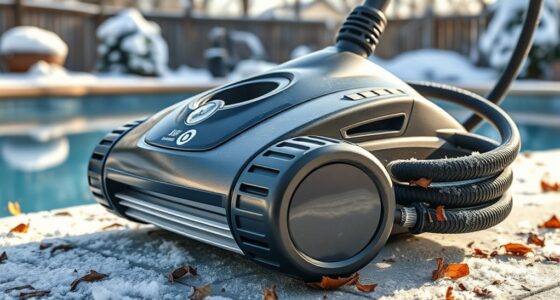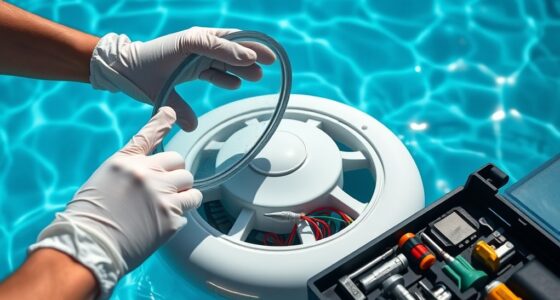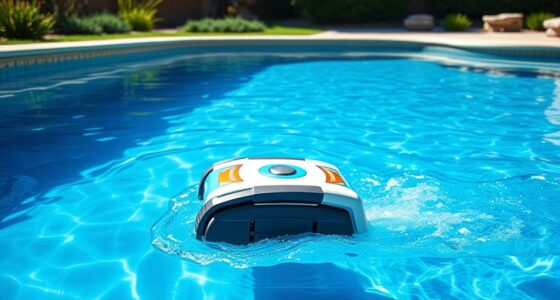Automatic pool cleaners are great at removing surface debris and dirt, but they have limited ability to eliminate algae and clear cloudy water. They can’t detect chemical imbalances or deep algae buildup. To keep your pool sparkling, you’ll need to combine cleaner use with proper chemical maintenance, filtration, and regular manual cleaning. If you want tips on how to improve your pool’s clarity and prevent algae, keep exploring for more helpful ideas.
Key Takeaways
- Automatic pool cleaners effectively remove surface debris but struggle with stubborn algae mats and thick algae buildup.
- They help improve water clarity by removing dirt and small particles but cannot treat algae chemically.
- Sensors and navigation systems ensure thorough coverage, aiding in debris removal and preventing cloudiness.
- Proper chemical balance and filtration are essential; cleaners alone cannot prevent or eliminate algae.
- Manual intervention and chemical treatments are necessary for comprehensive algae control and maintaining clear water.
Understanding the Capabilities of Automatic Pool Cleaners
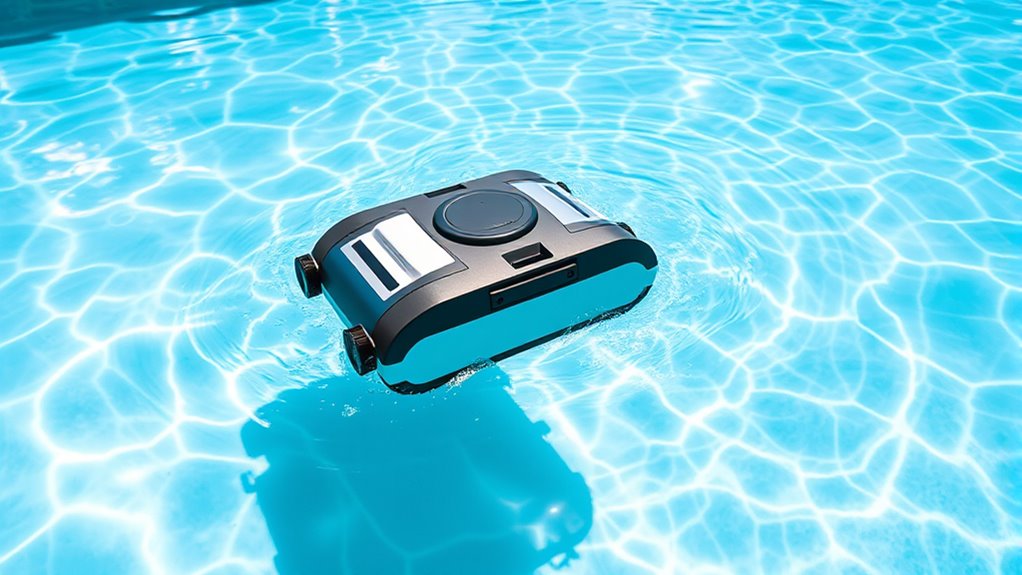
Automatic pool cleaners are designed to make maintaining your pool easier and more efficient by autonomously removing debris and dirt. Their robotic navigation systems allow them to move systematically across the pool’s surface, ensuring thorough coverage. This technology helps prevent missed spots and reduces your cleaning time. Battery longevity is another key feature, allowing these cleaners to operate for extended periods without needing a recharge. High-quality models often have smart navigation algorithms that optimize movement and conserve power, making them more effective and energy-efficient. Additionally, integrating features such as navigation technology enhances their ability to handle complex pool shapes and obstacles effectively. Modern models may also include noise reduction technology, which minimizes operational noise, making the cleaning process more discreet and less disruptive. With these capabilities, you can trust your automatic cleaner to handle routine maintenance, keeping your pool pristine with minimal effort. Understanding these features helps you choose a model that fits your pool size and cleaning needs.
How Automatic Cleaners Tackle Surface Debris and Dirt

Since surface debris and dirt can quickly accumulate in your pool, automatic cleaners are equipped with specialized brushes and suction mechanisms that target these particles directly. Their robotic navigation systems enable efficient coverage, maneuvering around obstacles and ensuring no area is missed. As they move, they pick up leaves, dirt, and other debris from the surface and bottom, leaving your pool cleaner and inviting. Filtration systems, including powerful suction components, work together to maintain a pristine environment. Additionally, advanced navigation technology helps these cleaners adapt to different pool shapes and sizes, enhancing their effectiveness. Many models also feature sensor technology that detects the amount of debris, optimizing cleaning cycles for better efficiency. These sensors can also identify algae and cloudy water, prompting the cleaner to adjust its cleaning pattern for more thorough results. Modern automatic pool cleaners often incorporate smart algorithms to improve their cleaning performance over time. Key features include:
Automatic cleaners efficiently remove surface debris with advanced navigation and powerful suction, keeping your pool pristine effortlessly.
- Precise robotic navigation for thorough cleaning
- Powerful suction to remove surface debris and dirt
- Optimized battery longevity for extended operation without interruptions
These features work together to keep your pool surface clear, saving you time and effort. With the right automatic cleaner, you can maintain a pristine pool environment effortlessly.
Limitations in Handling Algae Growth

Automatic pool cleaners often struggle with algae because of its sticky nature, making it hard to remove completely. They also can’t detect chemical imbalances or algae buildup deep in the water or on surfaces. As a result, algae can still grow despite regular cleaning efforts. Additionally, because these devices lack predictive analytics capabilities, they cannot anticipate algae growth trends or adapt their cleaning strategies accordingly. The inability to monitor chemical levels further limits their effectiveness in preventing algae proliferation.
Algae’s Sticky Nature
Algae’s sticky nature poses a significant challenge for pool cleaners, making it difficult for them to effectively remove these stubborn contaminants. The strong algae adhesion causes the algae to cling tightly to surfaces, resisting removal by automatic cleaners. Because of this, algae can quickly spread and form thick mats that block the cleaner’s brushes and filters. Additionally, automatic pool cleaners struggle with chemical detection, which limits their ability to identify and target algae growth early on. To combat this, you need to manually scrub affected areas and adjust chemical levels. Regular chemical treatments are essential, but proper maintenance practices are equally important to prevent algae buildup and ensure a clear, healthy pool. Keep in mind that algae’s adhesive properties often require more than just a vacuum:
- Enhanced scrubbing tools
- Manual intervention
- Regular chemical treatments
Limited Chemical Detection
Have you noticed that automatic pool cleaners often miss early signs of algae growth? This happens because they lack advanced chemical detection capabilities. While they’re great at removing debris and surface dirt, they don’t analyze water chemistry to identify imbalances that promote algae. Poor water chemistry, such as elevated phosphates or low sanitizer levels, can lead to algae blooms, but your cleaner won’t recognize these issues. Instead, it simply cleans what it can see, leaving behind microscopic algae spores or early-stage growth. Relying solely on an automatic cleaner isn’t enough to prevent algae. You need to regularly test and adjust your water chemistry to keep algae at bay, since chemical detection isn’t within the scope of these devices. Proper water maintenance is essential for a healthy, clear pool.
Surface vs. Deep Cleaning
While surface cleaning removes visible dirt and debris, it often falls short in tackling algae that cling to the deeper layers of your pool. Automatic cleaners excel at maintaining pool aesthetics on the surface, but they struggle with thorough deep cleaning essential for algae control. This limitation can compromise your pool’s clarity and hygiene, reducing user convenience. To improve results, consider these factors:
- Deep algae roots require manual or chemical intervention beyond surface cleaning.
- Automated cleaners may miss corners or under ledges where algae thrive.
- Regular brushing and chemical treatments complement surface cleaning for better algae prevention.
- Using vetted products designed for algae removal can enhance your pool maintenance routine.
Ultimately, a combination of deep cleaning strategies and automatic cleaners ensures your pool stays crystal clear and inviting, aligning with your desire for effortless maintenance and pristine aesthetics.
Effectiveness Against Cloudy Water Conditions
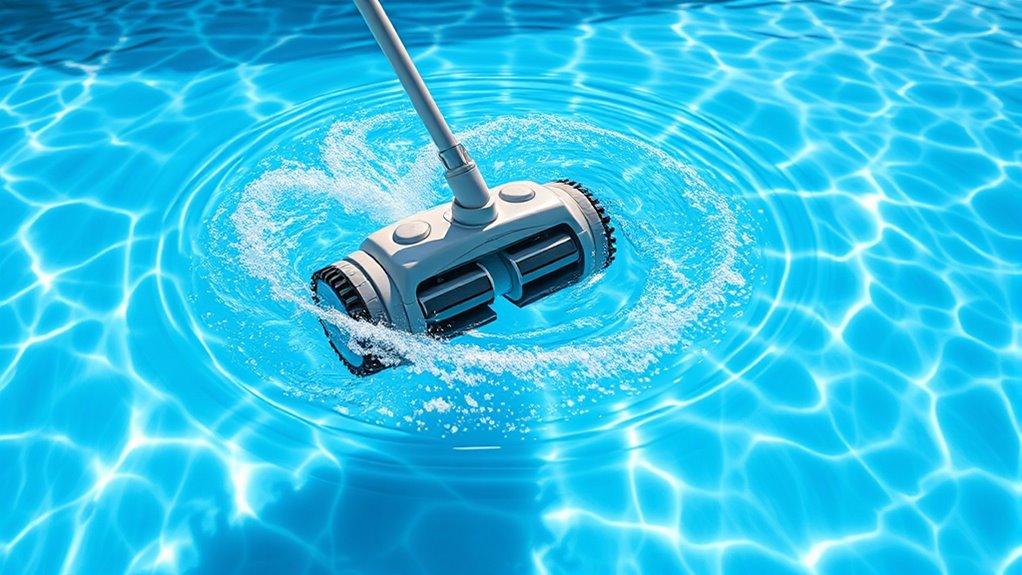
Automatic pool cleaners can be highly effective at clearing cloudy water, especially when paired with the right filtration system. Their automated navigation allows them to cover the entire pool efficiently, guaranteeing no areas are missed. Sensor accuracy plays an essential role in detecting debris and adjusting cleaning paths accordingly, which helps in breaking down particles causing cloudiness. These sensors can identify water clarity changes, prompting the cleaner to focus on problematic zones. As a result, they work faster and more thoroughly, improving water clarity over time. Incorporating wall organization systems can also help in maintaining cleanliness by reducing debris buildup on pool surroundings, further supporting water clarity. Additionally, tuning the filtration system ensures optimal debris removal and water flow, enhancing overall pool clarity. Regular maintenance of filtration components is crucial to sustain peak performance. Moreover, using appropriate chemical treatments can further assist in controlling algae and organic matter that contribute to cloudiness. Proper chemical balance is vital for water clarity maintenance, and combining it with mechanical cleaning maximizes results. Keep in mind, though, that while they markedly reduce cloudiness, they perform best when combined with proper chemical balance and filtration. This synergy ensures your pool stays clean, clear, and inviting for swimming.
The Role of Filtration and Circulation Systems
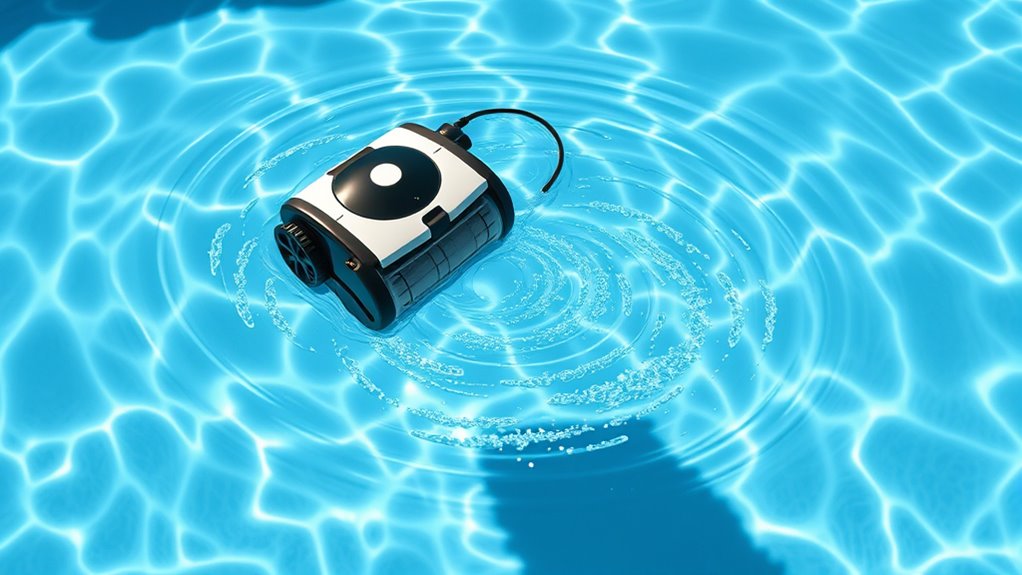
Your pool’s filtration and circulation systems are vital for keeping the water clean and clear. Efficient filters and well-designed circulation patterns ensure debris and algae don’t settle, reducing maintenance. Understanding how these systems work helps you prevent algae growth and improve overall water quality.
Filtration System Efficiency
A well-designed filtration and circulation system is essential for maintaining a clean and healthy pool. It ensures algae and debris are effectively removed, keeping your water clear. To optimize efficiency, focus on:
- Properly sized filters that capture tiny particles and prevent cloudiness
- Regular backwashing and maintenance to keep flow rates high
- Strategic placement of pool equipment, including solar heating and pool lighting, to promote even circulation
- Incorporating top-rated filters can significantly improve water clarity and reduce algae buildup.
- Ensuring consistent circulation patterns helps prevent stagnant spots where algae can thrive, especially around features like solar heaters. Proper circulation also supports pool chemistry balance, reducing the risk of algae growth. Implementing automatic pool cleaners that work in tandem with efficient filtration can further enhance debris removal. Clear water also enhances the performance of automatic pool cleaners. By maintaining a strong, consistent flow, your filtration system can better handle algae and cloudy conditions, reducing the need for chemical treatments and manual cleaning. Additionally, understanding the importance of filtration system efficiency helps prioritize upgrades that can further improve water quality.
Circulation Patterns Impact
Effective circulation patterns play a crucial role in maintaining a clean and healthy pool by ensuring water flows evenly throughout the entire system. Proper circulation prevents stagnant areas where algae and debris can thrive, supporting pool safety by reducing slip hazards and bacteria buildup. When water moves consistently, your filtration system works more efficiently, removing contaminants more effectively. Circulation also helps regulate water temperature, preventing cold spots and ensuring a comfortable swimming environment. If circulation is poor, algae can develop even with a good filtration system, making your automatic cleaner less effective. By optimizing circulation patterns—such as adjusting return jets and pump settings—you keep water moving uniformly, making algae more manageable and maintaining a safer, balanced pool environment.
Algae Prevention Strategies
Proper filtration and circulation systems are essential for preventing algae growth in your pool. When your pool’s water moves effectively, it helps distribute chemicals evenly, making algae less likely to take hold. Using a pool heater can maintain ideal water temperature, reducing algae-friendly conditions. Keeping chlorine levels steady ensures a hostile environment for algae, preventing blooms before they start. To improve your system, consider these strategies:
- Regularly run your pump to keep water moving
- Clean or replace filters to maintain filtration efficiency
- Adjust chlorine levels and consider using algaecides when needed
- Incorporating epic percussion sample libraries can help in designing sound effects for related educational content on pool maintenance.
- Conducting risk assessments of your pool’s water quality can help identify potential issues before they develop into algae outbreaks.
- Monitoring water circulation patterns can ensure even distribution of chemicals and prevent stagnation zones where algae could thrive.
Additionally, ensuring your pool’s filtration system is properly sized and maintained can significantly boost overall water quality and algae prevention efforts.
Importance of Regular Chemical Maintenance
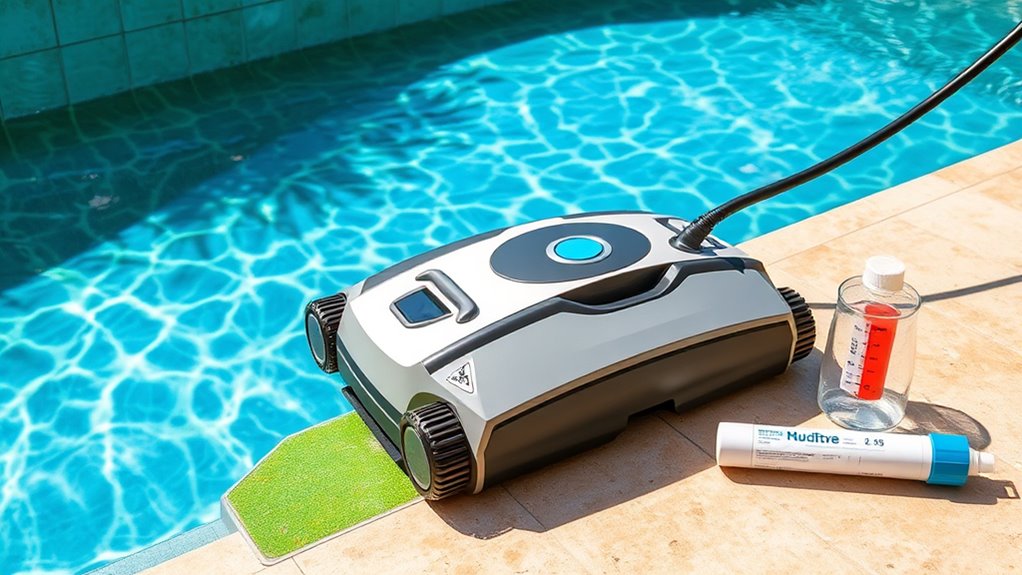
Regular chemical maintenance is essential to keep your pool clean, safe, and inviting. Proper chemical balance prevents algae growth, bacteria, and cloudiness, guaranteeing your pool remains a healthy environment. Consistently testing and adjusting pH and sanitizer levels helps maintain pool safety and prevents damage to equipment. Additionally, using appropriate filtration systems can help remove residual particles and improve water clarity.
Combining Automatic Cleaners With Manual Cleaning
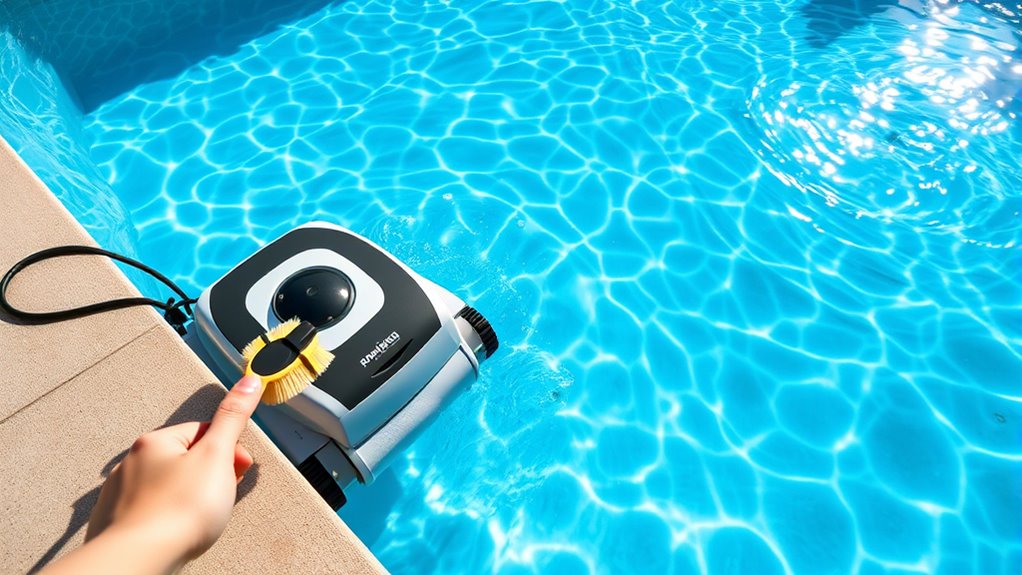
While automatic pool cleaners do a great job of keeping your pool tidy, combining them with manual cleaning guarantees a deeper and more thorough clean. Manual skimming and brushing target spots that automatic cleaners might miss, especially in hard-to-reach corners. This approach ensures better water quality, supporting healthy water temperature and enhancing your poolside relaxation. Regular manual cleaning also helps remove stubborn algae and debris, preventing cloudiness. To maximize effectiveness:
- Focus on areas where algae tend to cling
- Brush walls and corners for thorough algae removal
- Check and clean filters for optimal performance
Combining these methods keeps your pool crystal clear and inviting, making every swim more enjoyable while reducing the risk of algae buildup and cloudy water.
Upgrading Equipment for Better Water Clarity
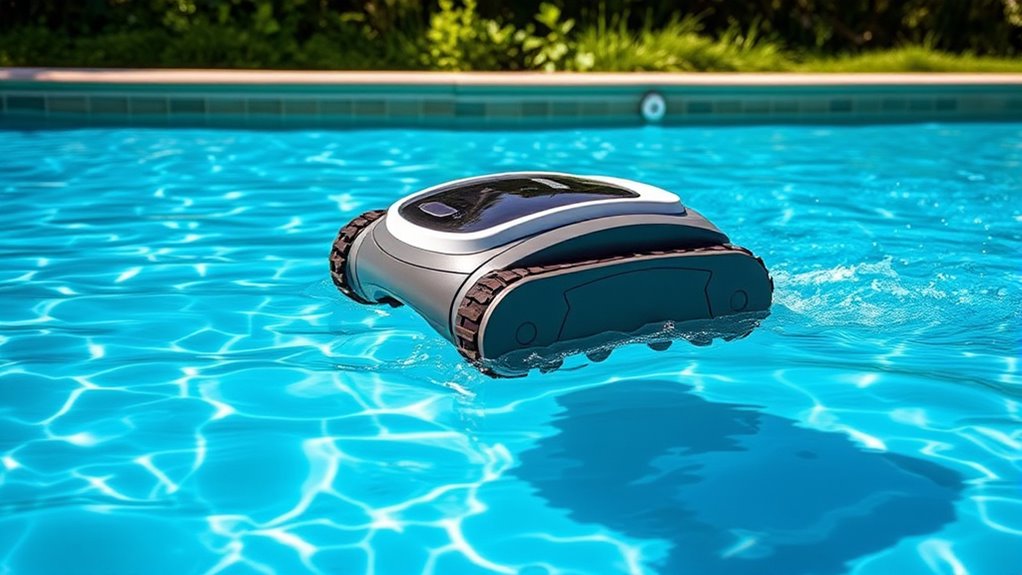
Upgrading your pool equipment can considerably improve water clarity and overall health. Installing a quality pool heater helps maintain consistent water temperature, reducing algae growth and promoting better chemical effectiveness. A reliable heater ensures the water stays warm enough for proper circulation and sanitation, which minimizes cloudy spots. Additionally, monitoring and adjusting your water pH balance is vital. Proper pH levels prevent algae and bacteria from thriving, keeping the water clear and safe. Consider using an automatic pH controller for precise adjustments. Upgrading to these systems not only enhances water clarity but also simplifies maintenance. When your pool equipment is optimized, your automatic cleaner works more efficiently, and you enjoy a cleaner, healthier swimming environment with less effort.
Tips for Preventing Algae and Cloudiness in Your Pool
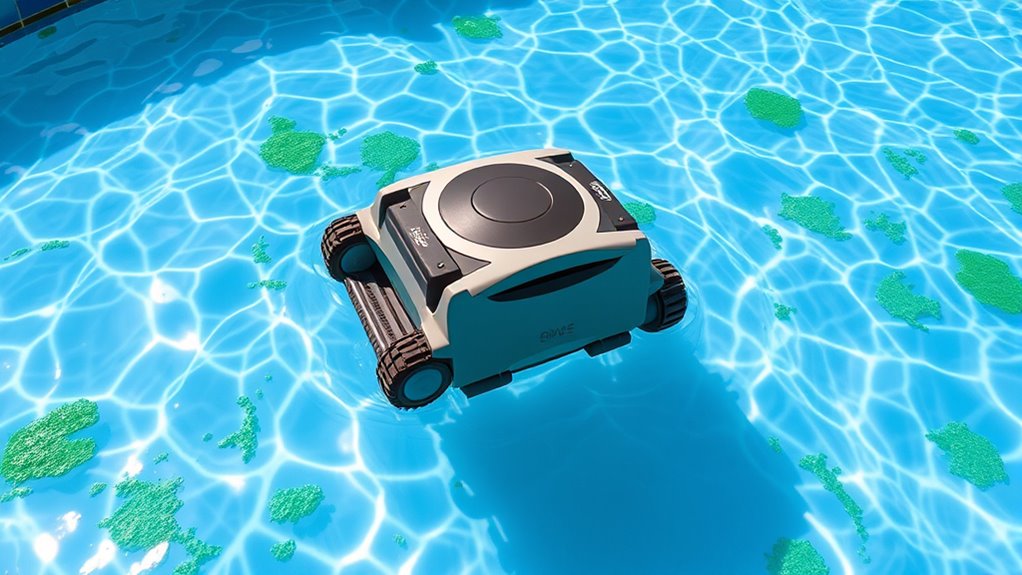
To prevent algae and cloudiness in your pool, maintaining proper chemical balance is essential. Regular water testing ensures your pH, alkalinity, and sanitizer levels stay in the ideal range. Proper pool heating can help prevent temperature fluctuations that promote algae growth. Consistently adjusting chemicals and monitoring water conditions keeps your pool clear and algae-free.
Here are some key tips:
- Test water weekly to catch imbalances early
- Use appropriate pool heating to maintain stable temperatures
- Balance chemicals to prevent algae and cloudiness
Frequently Asked Questions
Can Automatic Pool Cleaners Prevent Algae Outbreaks Entirely?
Automatic pool cleaners help with pool maintenance, but they can’t prevent algae outbreaks entirely. Regular monitoring, proper chemical balance, and cleaning are essential for keeping your pool clear. While equipment durability ensures your cleaner works effectively over time, relying solely on it isn’t enough. You need an exhaustive approach, including chemical treatments and manual skimming, to prevent algae from forming and maintain a sparkling, healthy pool.
How Do Automatic Cleaners Perform in Pools With Heavy Algae Growth?
Imagine your pool as a battlefield, and your cleaner as the brave soldier. When faced with heavy algae growth, automatic pool cleaners excel at algae removal and managing cloudy water, but they’re not miracle workers. They can substantially reduce debris and algae, yet heavy infestations may require manual intervention or chemical treatments. Rely on your cleaner to handle routine tasks, but don’t forget the importance of proper chemical balance for best results.
Are There Specific Models Better Suited for Cloudy Water Removal?
When choosing an automatic pool cleaner for cloudy water, you should consider filter compatibility and model specifications. Some models come with advanced filtration systems that trap smaller particles, making them more effective at clearing cloudy water. Look for cleaners designed for heavy debris and algae, as they often have more robust filters. Your choice should match your pool’s size and your specific needs for water clarity.
Can Automatic Pool Cleaners Replace Chemical Treatments for Algae?
Think of automatic pool cleaners as diligent garden workers, but they’re not chemists. They can’t replace chemical treatments for algae, no matter how tirelessly they sweep. Chemical alternatives are essential to kill and prevent algae growth, while manual cleaning tackles stubborn spots. Relying solely on cleaners leaves algae unchecked, turning your pool into a murky pond. Use both tools—automatic cleaners and proper chemicals—for a sparkling, algae-free swim.
Do Automatic Cleaners Require Special Filters for Algae and Cloudiness?
Automatic pool cleaners don’t necessarily require special filters for algae and cloudiness, but filter requirements can impact cleaning efficiency. Using a fine or multi-stage filter helps trap smaller debris and algae spores, ensuring better clarity. Regularly cleaning or upgrading your filter improves the cleaner’s performance, especially in cloudy pools. Focus on maintaining your filter system, as it plays a vital role in keeping your pool clean and clear.
Conclusion
While automatic pool cleaners are great for surface debris and dirt, they can’t fully eliminate algae or clear up cloudy water on their own. Regular chemical maintenance and proper filtration are essential to keep your pool pristine. So, isn’t it smarter to combine these tools with manual cleaning and proper chemical treatment? By doing so, you’ll enjoy a sparkling, healthy pool all season long without the guesswork. After all, isn’t your pool worth the extra effort?


